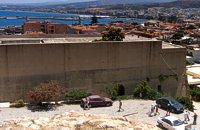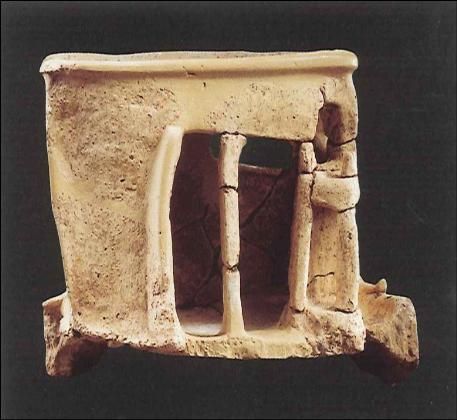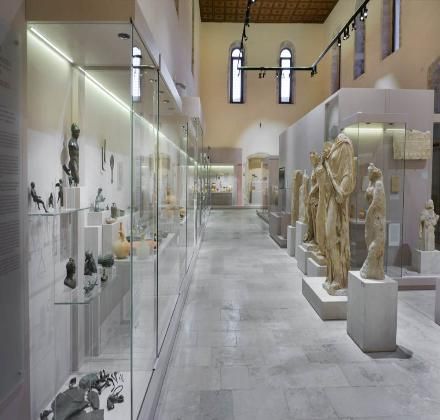
The Temporary Exhibition of the Archaeological Museum of Rethymno is housed in the church of Agios Frangiskos (St. Francis) and is in a transitional phase until the construction of the new Archaeological Museum, which will present the continuous history of the place from the antiquity to the recent times.
The core of the Rethymnon Museum was the archaeological collection of the Rethymnon Educational Association, which was formed in the second half of the 19th century. The collection consisted mainly of pottery, sculptures and coins with no indication of origin as well as some Egyptian objects and a glass Phoenician pavilion. The items were acquired by Educational Association through purchases and donations.
After the union of Crete with Greekce, the Museum acquired a public character and its collection was enriched with findings from the excavations carried out in the prefecture of Rethymno.
Until World War II, the Museum's collection was housed in a building in the Old Town of Rethymnon. In 1954, the Archaeological Museum of Rethymnon opened to the public in the building of the Venetian Loggia, where it remained until 1990, when it was relocated to the pentagonal fort in front of the entrance of the fortress of Fortezza.

Since 1991, the Archaeological Museum of Rethymnon has been housed in the pentagonal building opposite the main gate of the Fortezza. The building was constructed by the Turks in an effort to strengthen the city's defense. Due to the different functions that it served over the centuries - until the 1960's it housed the civic prison - its original form has been significantly altered. Due to the serious static problems of the pentagonal fort thearchaeological collection is transferred to the church of St. Francis.
The museum contains the following collections:
- Late Neolithic (3500-2900 B.C.) and Early Minoan (2800-2100 B.C.) finds from the caves Gerani, Melidoni, Margeles and Helenes
- finds from the buildings at Apodoulou, Monastiraki and the peak sanctuary at Vrysinas, dated to the Middle Minoan period (2100-1600 B.C.)
- Late Minoan finds (1600-1100 B.C.) from the cemeteries, the most representative being that of Armenoi
- finds of the Geometric (1000-700 B.C.) and Archaic (700-500 B.C.) periods from Eleutherna and Axos
- finds from Stavromenos and Argyroupolis (ancient Lappa) dated to the Classical, Hellenistic and Roman periods.
The most important items of the exhibition are:
 Clay larnax
Clay larnaxdecorated with a hunting scene. Found at the Late Minoan cemetery of Armenoi (1320-1200 B.C.).
 Figurine of the Minoan goddess.
Figurine of the Minoan goddess. The statuette represents the well-known Minoan female deity with upraised hands. It was found at Pangalochori and dates from the Late Minoan period (1320-1200 B.C.).
 Marble statue of Aphrodite.
Marble statue of Aphrodite. Roman copy of a Greek original, found at Argyroupolis. Dated to the 1st century A.D.
Marble violin-shaped figurine. It was found in the Gerani cave and dates from the Late Neolithic period (3600-3200 B.C.).
Clay model of a shrine. Preserved only in the upper part, it represents the upper floor of the shrine. It was found at Monasteraki and dates from the Middle Minoan period (1800-1700 B.C.).

Stone model of an offering table. The fragment preserves part of a Linear A inscription. It was found at the peak sanctuary of Vrysinas and dates from the Middle Minoan period (1700-1600 B.C.).
Pyxis strainer from Stavromenos. Clay footed vase with a lid and perforated base. The surface is decorated with painted rows of spirals and floral patterns. Dated to the Late Minoan period (1500-1450 B.C.).
Head of a terracotta female figurine. Found at Axos and dated to 530 B.C.
Part of a marble funerary stele. It bears the relief representation of a warrior carrying a shield. It was found at Eleutherna and is dated to the second half of the 6th century B.C.
Part of a marble funerary stele. A standing naked athlete is depicted, accompanied by his dog. It was found at Stavromenos and dates from around 460 B.C.

Rethymnon Archaeological Museum
St. Francis Church - 4 Agiou Fragiskou str.,
Telephone: +30 28310 27506
Email: efareth@culture.gr
Open
Winter: 08:00 - 15:00 November 1 - March 31
Summer: 10:00 - 18:00 April 1 - October 3, except Tuesday.1
Tickets: 2€ and 1€ for senior citizens aged over 65 years old and free entrance for students.